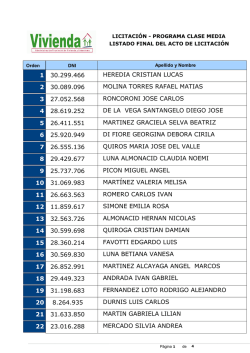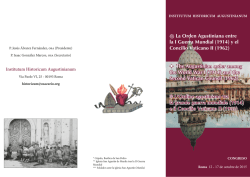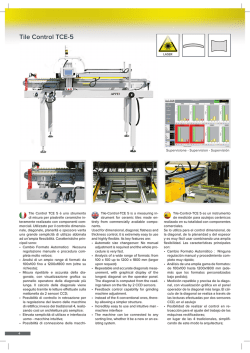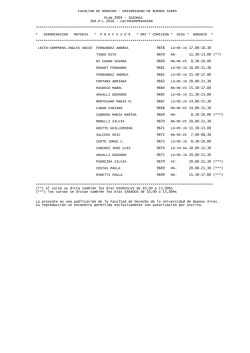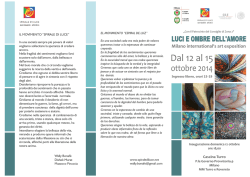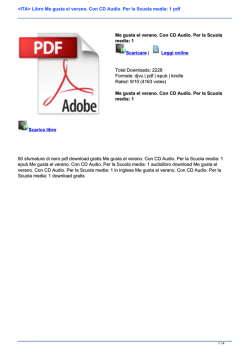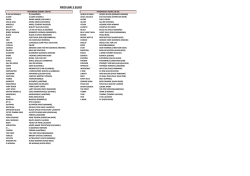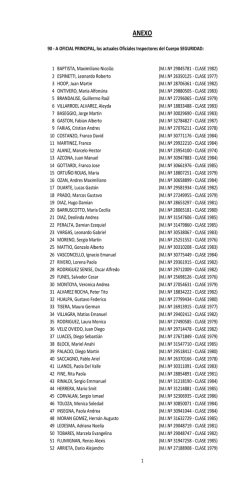
SPANISH 1 FALL REVIEW
Nombre
,,,,'
Clase
SPANISH 1 FALL REVIEW
SALUDOS Y PRESENTACIONES
Choose the correct words to complete the following dialogues.
1. Paco:
Teresa:
Paco:
Hola, Teresa. ZC6mo
ÿ:"ÿ.',,'U!ÿ':'ÿ(!(ÿ,"ÿ ..... ?
' ',/ "//,ÿ,ÿ,!vio.
I .... , ..,,,
Ve v\ ÿ,,4 t )1ÿ#1,ÿ,0,,"'
•
,1,ÿ
,Paco. LY
Regular,. l'ÿiÿJ (' ¢/::
".'
ÿ ......
-\
,
Te resa:
Hasta luego, Paco.
Paco:
Nos vemos,Teresa.
Emilio:
Buenos dias, Sra. Sÿnchez.
/
Sra. Sÿnchez' Buenosd[as, Emilio. L (,I 0 F','I (i)
Emilio:
Bien, gracias. ZY !,t'ÿ,'ÿ/ÿ..ÿ
/
%ÿ:ÿ
....................... (!ÿoÿ'ÿ,ÿ;;ÿ b,ÿ')
Sra. Sanchez:i' Bmen, gracBs.
1
Diego:
Buenas tardes, Sr. Ruiz.
Sr. Ruiz:
Buenas tardes, Diego. ............ l-?i) '-!ÿ-}ÿ;ÿ
Diego:
Sr. Ruiz, le present6-a m i a m!_ta ]u!ja.
Sr. Ruiz:
Mucho (ÿ,(;'!'ÿI
I;
/
, Julia.
Julia:
,
!
Sara:
Buenas noches, Sr. Diaz. LC6mo
Sr. Diaz:
Excelente, gracias. L
/
Sara:
Muy bien, gracias.
Sr. Diaz:
Sara, !ÿ/
Sara:
Sr. Diaz:
/
- 'ÿ ("
y
to?
/
Ud.?
presento a la nueva maestra, Sra. Flores.
Sra. Flores.
manana, Sara.
x=4
3
ARTICLESI PLURALS OF NOUNS
A. Agreement
1. gender: masculine (m) orfeminine (f)
2. number: singular(s) or plural (p)
B. definite articles: "the"
1. el = masculine, singular
2. los = masculine, plural
all mean "the"
3. la, = feminine, singular
4. las = feminine, plural
/
C,
indefinite articles: "a/an/one" and "some"
1. un = masculine, singular
means "a/an/one"
2. unos = masculine, plural
means "some"
3. una = feminine, singular
means "a/an/one"
4. unas = feminine, plural
means "some"
D. making nouns plural
<
1. nouns that end in a vowel: add-s
a. examples:
the pen = e,I ÿ['tqÿrct{O,
thepens= lOS boliÿrÿ¢roS
a consonant:
bouns
that end in
. examples:
(ÿraser= L,tÿ ÿOrÿ
someerasers= Ltlqa£ (ÿ0rrÿ
3. nouns that end in -z: change-z to-c anÿaÿÿ
a. examples:
Oight = !.£!:ÿ I b(ÿ, .-ÿ,ÿ/
lights= ÿ£ ÿ,ÿ¢S
Fill in the blank using definite articles (el, la, los, las) and the noun,
1. thecaIculator COiiukd6[(::)l'dÿ the calculators d__[_ÿ, iÿOt (ÿCLIOdÿif-O-ÿ<ÿ
2. the eraser I ÿ lq ÿ)rYÿ
3. the book
ÿ I}' blÿ0
12. theerasers }Ooo ÿfY-)C:ÿ]ÿ
@ thebooks IOÿ/IDFD.ÿ-
.ÿ ,ÿj ÿ
4, the paper ÿl DO.©Pÿ
5. thechalk /6 ÿZ(::tÿ
15. thechalks /'ÿ I-/2ÿ
6. the flag !Q.ÿ YOOlq<::!£¢o_
16. theflags IQÿ boiÿdÿ'-¢o,ÿÿ'ÿ
7. the notebook ÿ1 (4<(/(9ÿPÿrtqO
8. the map £[ lqÿd/ÿ
9. the backpack !0. it%%CChÿ l/Q_
10. the student (m) ÿ-ÿ[ Qqjÿ"U4:[idr/ÿ
OlqnqnO
G the notebooks
18. themaps 10=,ÿ
tÿthe backpacks
the students(m)
ÿ,1%1 'ÿ tt
t't',,. 5
'.¢;
Fill in the blank using indefinite articles (un, una, unos, unas) and the noun.
i. a class Iÿ I"IOtn I,.ÿ ÿ( ..
2. adesk lJn',
3.
.
S,
{Sil.ÿ)some classes.,..__.... Ur)ÿ
ÿ212) some desks [li"}()ÿ l:,ÿt.fLJI ÿ-1"-(ÿ:\
I
I
a table [.t'f]Q..
tÿ ÿ 'ÿ'
,)0,.':ÿ
a dictionary
ÿ(" l?c:ÿ<i,,.,ÿ::,C,
ÿ
i
13. sometables t!ÿOL',
i
;rÿ::Aÿ<'
ÿ
'/ d Iÿ (:l(>f !all ÿ ÿ'iÿ4-ÿ'ÿ some dictionaries t t lÿO' ÿ Cÿ / .<i& f 6 F, 4 r ÿ¢)'!:ÿ
aposter i!tÿ (('ÿ ÿc_{
050 some posters L,tlÿO > c,:.ÿ ÿ,,./<ÿ
.
,
' ....... I I! .... !';' ÿ':'ÿ 17. some wastebaskets &{triO_5 !'.)ÿ:,,[Jÿ:: [<7 ÿ'ÿ,.ÿ.ÿ
:),ÿL.jlÿfiilT. a wastebasketUr'ÿ ÿ' ':ÿ','?!
8.'ÿ,..elight !,ÿ'lÿO
+,, t ! 14'::'
'" '
18. some lights tjt\(.!'-'ÿ I Lt.(.:,
_ÿ
f
.!ÿ,<ÿ ,ÿ ,.
....
<-,
9. a teacher(m)t{?ÿ tÿ",(.I(: "ÿf)ÿ.ÿ(.,.,..::,,ÿ.ÿ)(19.)someteachers,,, 1 ltÿO.:: i'; ,'<,ÿ :,ÿ ,ÿ;ÿ:<.i.7).i,,ÿ..
10.-,achalkb°ard .
,ÿ
20. some chalkboards
/
Choose the correct definite or indefinite article, (Translate to check answers.)
4. El SeÿorOrtegaesÿ(a) profesor bueno.
5. No me gusta ÿ[ .(the) videojuego Dance Revolution porque no me gusta bailar.
SUBJECT-VERB AGREEHENT
Gwe the correspondmÿiÿ,Ubject pronounÿor each noun.
EX: Julio y yo = nosotros
!
1.
. dtÿ.
Felipe y iviar[a
ÿ"
,
Felipe ÿ:I ÿ ........................................ :ÿ+ÿ
r!
,
Maria <ÿ.1!ÿ< ÿ .................................................................. ?>
L i
4.
Y';i?ÿ;)"
:/": ''ÿ <Syq
Paco 7ÿ
"\ ÿ.ÿ.ÿ
........
Andr6syUd ,-:
' {(X•
nO:b>ÿ-,, ÿ:;<i ;
I
V
-7
7. Margarita .ÿi
,
Sara y Luisa ....... ÿ"
,
tt3 y,yo (l'ÿ$'-:.tÿ:,,' ':' "'
10,
4-hÿ. !nÿ-..n
q I ÿ Ct ::ÿ
it,
i'¸
Subject pronouns.
L
wo= n0 / ,o o o_s
I-- ÿ/D
you(familiar)= Iÿ
you (formal) = 11ÿ
they(m, m &f) = dloS
he= El
they(f) = ÿ110.ÿ
she-- d/ÿ
you all (familiar/formal) =
Theverbser andsubject-verb agreement.
L
Iam= 30ÿ
n050ÿ.s t noooÿros
we are = ;3f.3lY}Oÿ
---_ D' descr;phdn
you(fam.)are = e.Vÿ
! vÿ ÿ,, \, ÿ,,, .j ÿ,
he is= #ÿ_ÿ1 Q..ÿ
they (m,m &Oare = 6[105 qÿOÿ¢]
sheis= C,I}Q ÿ)
they (f) are = dlÿs ÿm
you (form.) are = Uÿ ÿ
youall (fam/form)are= ÿn-O,ÿLpÿCÿ.ÿ$ ÿOqFI .
C, Cha, rac'&<e
O, o, iÿin
THEVERBSER
Sub' ect-verb agreement,
Corresponding
subject pronoun
Subject
Form of ser
eS
i male
i female
Person y yo
"50ÿnOS
r,oÿ o -tvO S/¢-ÿ
Pers onytO ÿ0ÿ4ÿ
Person yUd. ÿuÿ 4 "g4
2 or.more people (m, re&f)
2 or mere people (f)
5orÿ
,Sÿr¢4eS
50qn
Lt,ÿ'f ¢,"4eÿ
,
elias
,ÿ d'¢!
Son
SER AND NOUN-AD3ECTIVE AGREEHENT
Fill in the blank with the correct form of ser and change the adjective to agree with the noun when necessary.
i: elloÿ-/
ÿ
,.
1. Los perFos ÿ5"ÿq, ,, gordo.
2. Siÿvÿlÿa.. ÿ% bonito.
3. Nro'ÿr-los .c--ÿmoÿ3 ÿe4,ÿadÿ. delcdoÿ4ÿ.
4;gio.
.
ÿ ÿ. ÿOÿs ÿ.r{_ ÿ.!ÿ,
%,IV{& ,S p¢ÿ,
Vhin.
m , ,ver ,do.
5, Yp(m) ÿJO'ÿ
guapo.
. F etl&ÿ
6. Ana ybara ÿP33 -ÿ4t-e-. Q-ÿJIÿ,
7, Ustedes (0. ÿO-qq
ÿe." inca %ÿnÿ8,
IOt4ÿ o.f¢- ÿerÿouS,
10. ÿamiÿ.a e$
ÿ pe%u.¢ÿoÿ,
7ocoxe., ÿ'Te, ÿo,. o j e_ ÿb/orÿ,
13. IflanuÿlSI ÿS perezoso.
r el kx.ÿ "1
14. Lascnmas Cÿl)-T3
rneFeno. TÿOftlÿq.$,
15. T fi(m) Pÿ('Pÿ simpÿtic0.
10.¢rÿ nice,, ÿ
NOUN-ADJECTIVE AGREEMENT
Adjectives describe nouns• In Spanish, adjectives mustagree in number (singularorplural)
and lender (masculine orfeminine with the noun.
masculine,
singular
adjectives ending
in -"e"
feminine,
feminine,
plural
singular
plural
seria
serias
serio
in -"o"
adjectives ending
masculine,
interesante
adjectives ending
serios
interesantes interesante
azul
in "consonant"
azules
azul
interesantes
azules
adjectives ending
in -"ador",
trabajador trabajadores trabajadora trabajadoras
nationality
Write a complete sentence using the following words. Change the verbs and adjectives as
needed.
1. Yoÿiiÿ}/ÿser/de gado
(]Q¢ ÿt:.
,,It(""........
1
TO (m)/ser/guapo.
I0
• Itq ÿCo
3.
IVlar[a/ser/rubio y bonito.
4.
Nicolas y Emilio/ser/alto y moreno.
5.
Felipe y yo/ser/amigos/bueno. ÿCti O,9, "ÿ:
iqct
/
yO S('ÿ Fÿ)QC d!m idni:; hH-e ÿlq'::
6.
Patricia/ser/paciente y serio.
7.
Ustedes/ser/tra bajador.
8.
Nosotras/ser/rubio y bajo.
Z%L__ÿ.ÿ..ÿ< ......... bÿ4\t:< " . ÿiÿ,.ÿ£ .............................
Fill in the blankwith the correct form of the adjective in Spanish.
(tall)
(lazy)
3. Di&gÿ>;Jatme son 'ÿbl ¢qf:ÿ(ÿ °!ÿ !CO'::',
• (nice)
• (hard-working)
s. El slen%lr ,uiz es '!"'; C, ,GO
• (thin)
6. LaS clÿicas son ÿ"
'ÿ' i .,4.
cÿ":'
,_)L4
,ÿ
• (serious)
7. ILos'maestrosson ÿ},?kl'( ÿ-iC!05
• (boring)
8. LasenoraKodnguezes ilÿ;ÿ ....
[ic],4">(V!ÿ,:!,,
0
. (smart)
Give the opposite of the underlined word,
1. Juan es alto, pero yo soy }gdljld)
2. Marfa es fea, pero tÿ eres
3. Ram6n es qracioso, pero Emilio es
4. Julia es fuerte, pero Diana es
5. TQ eresaburrido,
PRESENT TENSE OF -AR VERBS
The stem of the verb is everything without the -ar ending. For example, in the verb estudiar, the stem
is estudi-. The ending of the verb is the-ar. To conjugate a verb (put it in the form it needs to match
the subject) the-ar ending is removed and new endings are added to the stem. Here are the
endings that match each of the subject pronouns:
yo
-o
tÿ
nostros(as)
-as
........
l, ella, Ud. -a
-amos
ÿ.ÿj
ellos, ellas, Uds.
-an
Example of what to to below: Theformsoftheverbestudiarare:
yo
estudio
nostros(as)
estudiarnos
tÿ
es
tudi
as
l, ella, Ud. estudia
........
ÿ
ÿj
^ÿ"'
'':" :ÿ.
........
ellos,ellas, Uds.
C
estudian
verb and fill in the blank with the correct form
1. Yo ÿ'ÿ]C,_ÿ_%i ÿ(ÿ
hablar con elmaestro.
2. Uds. I'ÿC C£,i ;ÿOLÿ
sus cuadernos para clase hoy.
3. JLÿa" 1ÿ Pÿt ÿ-ÿ3J.
4. L Ki e c e_ÿ i ÿooÿq
escucharmÿs.
tÿ papel o un Iÿpÿz?
5. Mois@syyo lÿeCeÿSiÿ-ÿ
ttÿs
1. EmhiayJuan
QÿO{')
2. Yo no ÿLÿOÿ,
la computadora mucho.
una calculadora en mi clase de matemÿticas.
3. Nosotros ÿ5(ÿqq( ÿ
4. ÿ. L£S 0,-°o
estudiar estanoche.
plumas de tinta azul en la clase de ingl6s.
tÿ una mochila para llevar tus libros?
5. El rrÿaestro N.S CLJ
tiza para escribir en el pizarr6n.
7J, aJ
n tu mochil+[LA? ....... ÿ:ÿ V'ÿ'ÿ' I
-- ,- rCos a o,a e.
3. Losestudiantes ÿ'('Pÿ dÿl'ÿ
4. vo
5. Estebanyyo lt:d._VdLOqO,.ÿ
pantalones mucho.
los papeles a la maestra.
L
kO
o
a sus padres en casa.
2. Yo () k! tJC(t!ÿ
a Teresa con su tarea.
3. Los maestros 0ÿ/(.)L)'!(ÿi
4. 2. Q \[ I.[ dC..,ÿJ) ÿ'"
5, Jose yyo
j
a los estudiantes a aprender.
(ÿtu hermana aleer?
al maestro en la clase,
(ÿ ÿit.(ÿ... ÿ ÿ 0 ÿ ÿ
"ÿ
, _
( esperar = ÿ \r\) SJ,_ÿ
1. Los nifios () 2)'[3'¢? ÿ" ()f)
el autobÿs.
t
2. Marcos
<: c:ÿ [i.)ÿ" { L:!ÿ,
a su amigo.
3. Yo Pÿ:;f 3(> g 4')
4. Z
a mi madre,
tÿ al polk[a?
<ÿ °:,ÿ )'(' ( ...f ,.o:,
al doctor.
(preparari? 'I?3 !)l"(ÿ [)/i[(-',
i, Las maestras ,ÿ3fC I)("( I (:I 'I
las lecciones.
2, ElsefforGarcia C/<? Qÿ-?( ÿ"ÿ '
3, Yo
el examen.
i)f.(ÿ (Pcÿ-ÿ /)
para la prueba.
, t ,, 9
tQ la tarea para la clase de espaÿol?
5. Nosotros f)ÿ ¢ (ÿ,) ÿ"ÿ:,t 'iY ÿf;;" )
1, Patricio siempre
/
L)
para el examen dificil.
I I,,,/Z',' ÿ,
..... i
a clase con su tarea.
Uÿ
tO a clase con tu libro?
......
a clase tarde.
3. Pepey yo nunca
a casa a las cuatro de la tarde.
4. Yo
5, LOS chicos "-;ÿ1/'(?ÿ[L-t," I'ÿ
escuchar =
£__
a la escuela a las ocho de la manana.
i. < ,\_ ,.. v-,
ÿ () ÿ\ Lÿ 't,U(
a la maestra.
2. Los hijos (' ÿ:ÿ (' ÿJ, (' ÿ'ÿ 1() t'jÿj,,
,e:' r_,,
3, Yo ......
,ÿ,( '! ,! ,L 1,' ÿ ÿ)
a sus padres.
mÿsica cuando estudio,
tÿ la lecci6n?
5. Enriqueyyo
(b ÿ:,(.(1(_ ÿ/}ct rÿ ÿ!i"
el cassette,
t
mirar = ';i ÿ ) <ÿ ÿ:' (::',.,,. .....
1. El chico
2. Yo
Y'lq ÿ r ÿ.4,
iÿ i ( t')
3, Teresa [Y3 [ fÿ'(*ÿ ÿ
4, Nosotros F?ÿ t'[t J ....
I'ÿ}L),ÿ'
- ,ÿ ...............
: .:2.
5, EIIos [ Yÿ I' [ tl 1ÿ)
a la chicaguapa,
el pizarrdn.
la televisidn.
al maestro.
los papeles.
p..
ta0
2. Miguel ÿfÿ I0ÿ,
3. Los estudiantes ÿÿn
4. Yo ÿI 0
(
ingl6s.
mucho en clase.
con mi amiga por teI@fono.
5. Jaime yyo ÿqQÿlÿqOÿ
en clase aveces.
trabajar = ÿ ÿJ(ÿl(ÿ
en una escuela,
en un restaurante.
2..ar,o
3. Losestudiantes ÿmÿ'OÿÿN
mucho en la clase de ciencias.
tO en lacafeteria?
5, Juanayyo
Gÿct ÿ-Iff!Oÿ
en un hospital.
entrar(en, a)= ÿ P-ÿJI-CIÿ
1, .osotros e-ÿa£D£ ÿ;
2. Paco
ÿfrÿ
en la escuela.
en el apartamento.
en la oficina.
3. Dos estudiantes erÿfÿ.ÿ
4, Laura yt6 ÿnÿPÿ
la casa.
la clase un poco tarde
Fill in the bla n kwith the correct form oftheverb in parentheses,
Manuel la mQsica? (to listen)
espafiol bien. (to speak)
3.
Io
4. Uds. eDOlÿSlÿtfÿ
yo bien? (to dance)
preguntas en clase. (to answer)
Uds. a veces? (to sing)
6. TLÿ p rep&ras
la casa para la fiesta. (to prepare)
tÿ un Iÿpiz a clase? (to need)
Translate the following sentences to Spanish. Remember that the formula for a
question is:
,
2.
3,
4.
5,
,
7.
8.
9,
10.
11.
(
, T.ranslÿeÿpanish.
,.ÿSometimes I iÿelp my brother with his (su) homework.
',ÿ'ÿudents ÿ need a pencil in class.
3. We never use a calculator in math class (the class of math).
?. f ',
,.,Jÿ .ÿ.,> '" ÿ[)ÿ; /ÿUtltc,,.:_ÿ. LI,)+.<ÿ ÿ1 ,O{ÿ 1.7/1(ÿ2 (ÿ....)/<'tt/,',ÿ "1.,ÿ .,!. .Cl/O (7
Are you (familiar) looking for your (tus) books?
•_ '_,) I (.(,.)) JJIJt>d(ÿ!),
7ÿ) !-L,/<;
/ Ik t'itÿ,,:::;,
(. "1-2..ÿ,
I
5. The teacher enters (in) the school.
7 • L'-ÿ i" }')ÿ :t :':.ÿ ! ÿ ,42.,
] ¢€ F)'ÿ- I"0,_,
L. ÿÿ ÿ" ) /GL.. ,ÿ-' ..... ÿ') ÿ" L. (C' ! (A',
Pepe and Maria arrive late to class once in a while.
.
•
,,
]!("
(,ÿ ,
7. My dad answers the telephone little.
".() l.Af) I ji'j (/) '
8, The English class (class of English) is difficult.
,J
-ERVERBSIN THE PRESENTTENSE
leer = to read
yo leo
nosotros leemos
tQ lees
1, ella, Ud. lee
ellos, elias, Uds, leen
Fill in the blankwith the correct form of the -erverb in parentheses. Use the following verbs:
'
Todos Iosestudiantes <',(ÿ7 ; ÿ,ÿxÿ ÿ>
Yo
d: d) I" iÿ ()
Emilla
.I
I,ÿ':'ÿ, 'kÿ-,
t ellibro. (read) t-c d.('
() r- (:t ÿLÿ¢' ÿ,,"
,refrescoÿ>ÿ.ÿ veces. (dri n k) tO": {:)<'t
tlÿmuchoen aescuea (earn) .1. i:ÿ ' ÿ":'ÿ"
Juan nunca 2117ÿ, iÿ )C .'
Paco y yo
understand) ÿ:ÿ,ÿ;;.,ÿ., ÿ >.ÿ :c<,."ÿ
enel parque!ÿias. (run) d.o¢ r(: ¢
Inÿsyyo ..... °ÿ 1)"ÿ'ÿ lÿ iÿ.:, ÿÿ
!. ;
L
:ÿ
fruta; nolegusta, (eat) <' ÿ)ÿÿ ',<'t
¢[,
V (ÿ 1" ', I 1) ,,_ÿ
z Lg<ÿ I
la televisi6n mucho. (see) xI (: I -
Uds, p(poernasen la clase de ingles? (read) IUt:.
k, I:ÿ:<'I:, . )
L
ÿ"$f fÿ )t",":'l.- ÿu.<. ,ÿ
Nosotros .]] ÿ. ÿP O t 7 'ÿd) ,:",'
I
"" ttÿ ala maestra? (understand) _."",41ÿ, ÿ,?)..' ', ; , ..... f''
agua cuando tenemos sed. (drink) ÿ)ol ÿ"ÿ
unat[orta,,cuando tiene hambre. (eat) ÿ ÿ,:ÿ ÿ ÿ<.ÿ
,,ÿ ÿÿ ÿ.ÿ. ;
Yo Cÿ. I:)[ ÿ,:2. l'"IC:le:':ÿ
m£scuandoestudio, (learn) (',. i./€:!',ÿ '.,: ÿ>,',,
Nosotros
en la pr£ctica de b£isbol. (run) c:,:.ÿ,, j,-.,,."
ÿ .ÿ .ÿ if f ÿ.; f ÿ. Jÿ d-:,.
bb
eÿ
.ÿ.
' '
Sÿ¢ ÿb@
d
yo abro
nosÿabrLmos
1, ella, Ud. abre
, Aÿ\f-ÿ.L\'ÿ
ellos, elias, Uds. abre_nn
Fill in the blankwith the correct form ofthe -irverb in parentheses. Use the following
verbs: abrir, compartir, escribir, recibir, vivir
1. ZPor quÿ no (_ornp4rtÿs
t6 la comida ( food)? (share) O01qÿ ÿ9dÿ ÿ-{ff
2. Yo ÿ,_%Ci-b ÿ:bO
mucho en la clase . (write) ÿ<ÿCf- I b iC
3. Nosotros abcÿ'rÿ0S
los librosa la pÿgina 5. (open) OÿoPi ff
4. Ram6n
V I Vt
5. Losniÿos
en una casa grande. (live) ViV {{
Fegÿ.ÿ, en sus cumpleaÿos. (receive) ÿC{b iF
Xf'l #ÿrh
6. H6ctor yyo ÿ rÿ [3ÿ. ¢ ÿqOÿ
-ÿt-odas las cosas (things). (share) dOC(h ÿo. r" Jÿi Iÿ
7. Nosotros !-d'.d ÿ ÿ--) ¢
regalos en la Navidad. (receive) 1-<1 ci ÿi t-
en u n fÿlSaÿLÿaÿtÿ.lÿ (live) V i V i ff
8. Pepeyyo ÿ'ÿdÿÿ
%._ .ÿ_ it4!0ÿ +%lLJ
a las ocho. (open) Oÿb ri
C
'
tQ cartas (letters) a Iosamigos? (write) e.scri bilÿ
Conjugate the verb ESTAR
o
nosotrosÿ nosotras
ÿ S ÿOX/
td
4ÿob¢ Oÿor°
5
e
Ud., ÿ1ÿ ella
Uds., EIIos, elias,
ÿ ÿ)ÿ
Fill in the blanks with the correct form of ESTAR.
f:, ÿ ÿ--ÿ1
3. Papÿyyo ÿ--eOlÿ..ÿ.lenÿuatemala.
r(lÿ
4. ÿ,profesordeespaÿoÿ eÿaÿ
leÿ-TÿSolvador,
M
ÿ
• I
9, LD6nde
O:i,'
l ¢'
..-.,)
10, Mi mochila
.......
ÿ ÿ ÿ(}'
tu mochila? / () ÿ(:t
debajo del pupitre. / 6 d'dÿ //Lÿ2 )
The verb Gustar
Gustar is a bit of a weird verb, because it actually means "is pleasing to." So you have to specify
WHO it is pleasing to. Me gusta, te gusta, le gusta, etc. Here are the conjugations for gustar:
Write outthe appropriate form of GUSTAR (me gusta, te gu sta, le gusta, nos gusta, nos g ustan,
lesgustan)
Tell what activity each person likes to do.
"i:-? )
......
'
3. you:
t
i
'"
,
.
he/she:-ÿ
of,o
5, I:
6. you:
,i£.'
'
'
,:Zÿ '.-I ('U:I '1 t'?l ¢ ,'
g
8. he/she:
QUESTION WORDS
Lpor qu6?
¢ ÿ_quÿ?Lcuÿnto(a)?,
why? V/q/
what? ÿ/ÿ/'
how much? ÿ/
because ÿ7
0 2,cu4ndo.ÿ
when? d'ÿ"
2_cuÿntos(as)2
e ÿ_d6nde?-
-quiÿn(es)?ÿ ........... who? 4'
&cuÿl(es)?ÿÿwhich? ÿ/ÿ
(ÿ where1)''
0 porqueÿ
a Lc6mo?
=how many? v/
where? ÿ/ÿ/"
..........
how? ÿif
=ÿ-ÿ-ÿ ÿ_de quiÿn(es)ÿÿL-ÿ
Fill in the blank with the question word that best matches the answer.
1. ÿ. ÿ-'ÿ(ÿlÿd ÿ
trabaj_a Julieta?
2. ÿ :][ÿOfqÿ•
estudian Uds.?
3. Z £f3ÿ OlÿJ4 ' trabajaS?(Jl])
4. ÿ_ (ÿ tÿi ÿ1ÿ
hablan?
6. L_ÿAÿ¢ÿOÿ
Iibros hay?
8. ÿ_ (-ÿLI'ÿ
9. Z ÿ1 ÿ1 ÿ !1--O
10. Z ÿ. bt{ÿfq
Estudiamos en la biblioteca.
(:-ÿ0")Trabajo porque necesitodinero.
prepara la lecci6n?
5, Z (ÿ!,t'}ÿr3ÿ
"
7. ÿ #(ÿl'ÿqO
(:db)Trabaja en un restaurante.
.Laenÿtaÿestra prepara la lecci6n.
Los ÿeÿuSd i antes hablan.
(
Hay doce libros.
pronuncias ingles? (!o')Pronuncio ingles m_u_y_bien.
busca Ram6n?
estudia Ud. ?
Busca el libro de historia.
(t 0")Estudio mucho.
tiene el papel?
Dicg&tiene el papel.
Translate to Spanish,
1. Are the studentshelping?
edud on ¢ ?
2. Does Maria singsometimesÿ tOfTÿ ÿO,r'ÿYÿ (2
3. Do you (familiar) drinkwater every day?--v-
vec.e.s TL A eeMo md .?
?
cada. To?
4. Who (singular) is buying the soda,?
5. What are we Igstening to? (HINT: There is no word for"to" in this sentence.)
C,,1
6. Why are you all working? _tÿ
cu
--ÿ
'
t:¢
,
Who (plural) is arriving late? ÿ iS',i
'/
J•
"' 'q ? I" •{ L
8. When is thetest? ,
/,
'ÿÿ /"
.....
I
";
'ÿ
9. Where do you all study? '
G
,.
ÿ,-- t-7 i.,4.
....
I,
[
ÿ'
,ÿ,!
tÿ ÿ'ÿ ÿ
NUHBERS FROH ZEROTOTEN, DAYS OFTHEWEEKIALPHABET
Write the answers in words to the following math problems.
1. dos x cuatro = (L:ÿ. ÿ"ÿ ..::
'?_
z-l
2. siete+uno= ÿ:')d /ÿ
,.
3, nueve- cinco = C'L,I!:ÿ'I iv, "ÿ
<q
,!:/
4. diez+dos= Cÿi:ÿ.,=ÿ, ÿ.ÿ
! +?
2,
5. cuatro-tres= !ÿ y-ÿ/'ÿ
t
6. ocho x cero = Cÿ¢_.ÿ <j
(:)
,,v
4"]1
C)
7. cuatro + seis=
,<1'\ÿ. "ÿ '!
to
Tell what comes next in each series.
1. dos, 'I f-ÿ711ÿ
<
7. ocho, nueve, C! iC.'!ÿ
cuatro
8. tres, [' t.xC.i..t; ÿ"0
2. ÿ!' ÿiÿ.ÿ;ÿ'ÿÿ ÿ:,ÿ cinco, seis
/3. de, e, efe,
1"'ÿ '.I"ÿ
9. hache,.
;
•
"
, nueve
,' <t !, ....
.!: +,
/
#i griega, zeta
" ' ' < '< ÿ:''
,ÿ ,
, ÿ ÿV'ÿ
,..' i,+ÿ.i.<ÿ, ÿ ÿ'fl'"
.,jota
..ÿ
10_ ele,6ile, ,t >l i'¢+ ,';.. )
)
11. ClOi'aliql,7,f"ÿ
5. martes,.hqÿ_ I-c_o!<.C'.'ÿ ,jueves
enetx
, lunes, martes
,,}
12. miÿrcoles, ÿ tÿ"";iÿÿ<ÿ
, .,ÿ .... ÿ
6. jueves,. '-,! ! (i ÿ ÿ ',c' 1_; ., sÿbado
,viernes
Answer the following questions.
1. 2,C6mo te llamas?
2. 2.De ddnde eres?
\}/<.
3. 7.Cuÿl es tutelfifono?
ÿ;:
..
"7[..f(.."ÿ,,<L}i'f' ÿ ,ÿ
.........
4 ,',l,'/,
4, i.Qufi dfa es hoy? Iÿ
5. ZQuÿ dfa es mafiana?
i'Dtÿ: .t'ÿ.r, r
ÿ:!ÿ<::.. -ÿ:' l Olÿ<'< .... 4:-t("* ,;::"i ',';ÿ iP
,]¢ it iÿ
Or3
o
Read the following personal ads from a popular Spanish magazine, Chispas. Who would you like to
meet? Answer the questions that follow by choosing what each person likes to do, mark A if the
statement is cierto and B if the statement is false.
,
\
(rÿ
+.
Hola, LQu.ÿ tal? Me llamo Monica. Me gusta ver MTV en la
ball,
et musica
y
" modern&
"4" "
......
tele, bai!ÿ .escuchar
Np me
gusta
c-
ni practicarÿteportes.., ni coÿer, ni nÿdar.. LY qu6 mÿsd iMe
gusta MUCHO leer Chisp, as, mi rev!sta'ÿavorita!
o LQu.6 tal, amigos? Me llamo No& i.Qu& me gusta hacer?
Depende de la estaci6n. En el verano, me gustatnadar. En el
otofio, rne gusta montar-ÿn bicicleta. En la primavera, me
gusta coÿrer, i Yen ei invierno? Me gustajuRar+videojueg'os.
Me llamo Javier. LTe gusta, ba!lar? iA mÿteÿlbU,ÿ -ÿ
gusta trabajar? iA rnÿ tampoco! En todos los meses del afio,,
me gusta tocaÿa guitarra con mi banda, "Los Animales", Me
gusta mÿs caÿar,,, rnfisica roclc LY a ti?
(,/
M6nica es aftlstica y le gust a ÿ;er'la tele.
M6nica es una chica muy>(:J-eportista.
A No6 le gusta jugar video juegos en la prÿm,avera.
A. Cierto
A. Cierto
A. Cierto
A No6 le gusta practicar deportes tÿ.Yÿ
A. Cierto •
B. Falso
A Javier le gusta bailar y tocar la guitarra.
A Javier le gusta trabajar.
- .......
A. Cierto
Write the following times in Spanish:
9:00 r,u v
(
bO
© Copyright 2024
